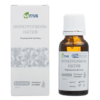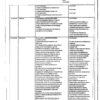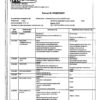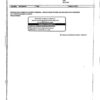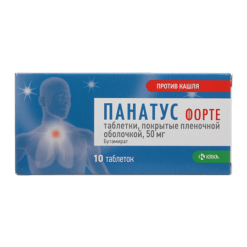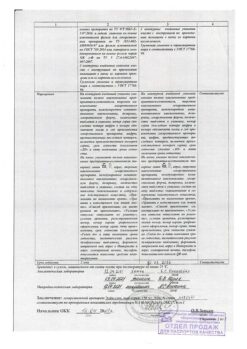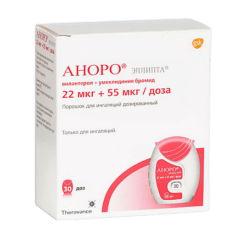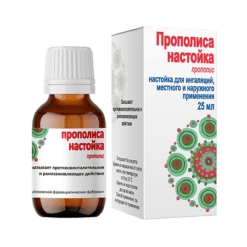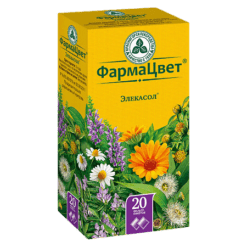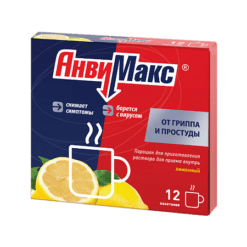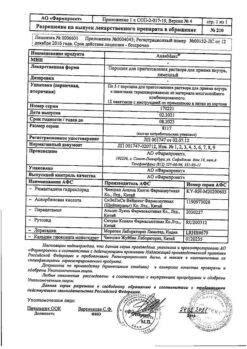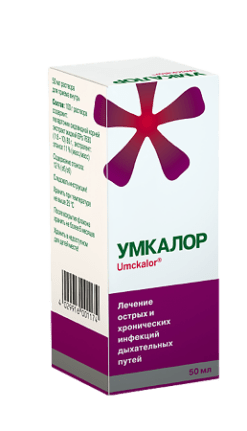No products in the cart.
Ipratropium-nativ, 0.25 mg/ml 20 ml
€6.49 €5.68
Description
The bronchodilator blocks m-cholinoreceptors of smooth muscles of tracheobronchial tree (mainly at the level of large and medium bronchi) and suppresses reflex bronchoconstriction. Having structural similarity with acetylcholine molecule, it is its competitive antagonist.
It effectively prevents bronchoconstriction resulting from the action of various bronchospasmic agents, as well as eliminates bronchial spasm associated with the influence of the vagus nerve. When administered inhaled it has practically no resorptive action.
The bronchodilator effect develops in 5-15 minutes, reaches its maximum in 1-2 hours and lasts up to 6 hours (sometimes up to 8 hours).
Indications
Indications
Treatment and prevention of chronic obstructive respiratory diseases: chronic bronchitis with broncho-obstructive syndrome (with or without emphysema), mild to moderate bronchial asthma, especially with concomitant diseases of the cardiovascular system; bronchospasm during surgical operations.
Preparation of the respiratory tract before the administration of aerosols of antibiotics, mucolytics, corticosteroids, sodium cromoglycate.
Pharmacological effect
Pharmacological effect
A bronchodilator, it blocks m-cholinergic receptors of the smooth muscles of the tracheobronchial tree (mainly at the level of large and medium bronchi) and suppresses reflex bronchoconstriction. Having structural similarity to the acetylcholine molecule, it is its competitive antagonist.
Effectively prevents the narrowing of the bronchi that occurs as a result of the action of various bronchospasms, and also eliminates bronchospasm associated with the influence of the vagus nerve. When used inhalation, it has virtually no resorptive effect.
The bronchodilator effect develops after 5-15 minutes, reaches a maximum after 1-2 hours and lasts up to 6 hours (sometimes up to 8 hours).
Special instructions
Special instructions
Use with caution in the form of inhalations in patients with angle-closure glaucoma, urinary tract obstruction due to prostatic hyperplasia.
If emergency relief of an attack of suffocation is necessary, monotherapy with ipratropium bromide is not recommended, because its bronchodilator effect develops later than that of beta-agonists.
The safety and effectiveness of intranasal use in children under 12 years of age has not been determined.
Impact on the ability to drive vehicles and operate machinery
Given the possible effect of ipratropium bromide on visual acuity, during treatment, caution should be exercised when driving vehicles and other potentially hazardous activities.
Active ingredient
Active ingredient
Ipratropium bromide
Composition
Composition
Active ingredient:
0.261 mg ipratropium bromide monohydrate equivalent to 0.25 mg ipratropium bromide.
Excipients:
sodium benzoate,
disodium edetate dihydrate (corresponding to disodium edetate),
citric acid monohydrate (corresponds to anhydrous citric acid),
sodium hydroxide to pH 3.4±0.1,
water for injections.
Contraindications
Contraindications
Hypersensitivity to ipratropium bromide.
Mainly for systemic use: increased intraocular pressure, prostatic hyperplasia, mechanical stenosis of the gastrointestinal tract, tachycardia, megacolon, first trimester of pregnancy.
Side Effects
Side Effects
Many of these adverse reactions may be due to the anticholinergic properties of ipratropium bromide.
The drug Ipratropium-native, like any inhalation therapy, can cause local irritation. The most common adverse reactions reported in clinical studies were headache, pharyngeal irritation, cough, dry mouth, gastrointestinal motility disorders (including constipation, diarrhea and vomiting), nausea and dizziness.
Adverse reactions are distributed according to frequency of occurrence. The following criteria were used to assess frequency: very often (>1/10); often (from 1/100 to 1/10); uncommon (from 1/1000 to 1/100); rare (from 1/10000 to 1/1000); very rarely (
Infectious and parasitic diseases: often – flu-like symptoms, upper respiratory tract infections; infrequently – urinary tract infections. Immune system disorders: uncommon – hypersensitivity, anaphylactic reactions, angioedema (Quincke’s edema).
Nervous system disorders: often – headache, dizziness.
Violations of the organ of vision: infrequently – blurred vision, mydriasis, increased intraocular pressure, glaucoma, acute pain in the eyes, the appearance of a halo around objects, conjunctival hyperemia, corneal edema; rarely – disturbance of accommodation.
Cardiac disorders: uncommon – palpitations, supraventricular (supraventricular) tachycardia; rarely – atrial fibrillation, increased heart rate.
Vascular disorders: frequency unknown – decreased blood pressure (hypotension).
Disorders of the respiratory system, chest and mediastinal organs: often – pharyngeal irritation, cough, shortness of breath; uncommon – bronchospasm, paradoxical bronchospasm, laryngospasm, pharyngeal edema, dry throat, sinusitis.
Gastrointestinal disorders: often – dry mouth, nausea, impaired motility of the gastrointestinal tract; infrequently – diarrhea, constipation, vomiting, dyspepsia, changes in taste, stomatitis.
Disorders of the skin and subcutaneous tissues: infrequently – rash, itching; rarely – urticaria.
Renal and urinary tract disorders: uncommon – urinary retention. If any of the side effects indicated in the instructions get worse or you notice any other side reactions not listed in the instructions, tell your doctor.
Interaction
Interaction
When used simultaneously, β2-adrenergic agonists and xanthine derivatives potentiate the bronchodilator effect of the drug.
The anticholinergic effect is enhanced by antiparkinsonian drugs, quinidine, and tricyclic antidepressants.
When used simultaneously with other anticholinergic drugs, an additive effect is observed.
Patients with angle-closure glaucoma should use Ipratropium-native with inhaled β2-agonists with extreme caution, as the risk of developing an acute attack of glaucoma increases.
Ipratropium native, solution for inhalation, should not be administered simultaneously with cromoglycic acid inhalation solution, given the possibility of precipitation (precipitation).
Overdose
Overdose
Symptoms: no specific symptoms of overdose have been identified. Given the breadth of therapeutic action and the local method of administration of the drug Ipratropium-native, the appearance of any serious anticholinergic symptoms is unlikely.
Minor manifestations of systemic anticholinergic action are possible, such as dry mouth, accommodation disturbances, and increased heart rate.
Treatment: symptomatic therapy.
Manufacturer
Manufacturer
Pharmstandard-Leksredstva, Russia
Additional information
| Manufacturer | Pharmstandard-Leksredstva, Russia |
|---|---|
| Medication form | solution for inhalation |
| Brand | Pharmstandard-Leksredstva |
Related products
Buy Ipratropium-nativ, 0.25 mg/ml 20 ml with delivery to USA, UK, Europe and over 120 other countries.





